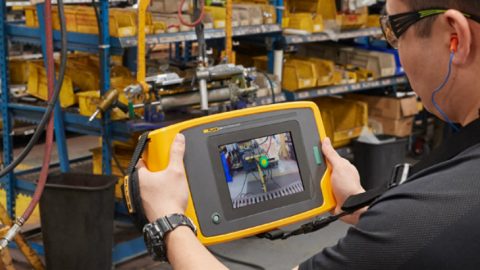
Fluke's ii900 device
Fluke’s new ii900 sensor technology has the ability to combine images and sounds to accurately identify air leak locations in the production environment.
When it comes to cost savings in industrial production, one of the first things that manufacturers often mention is solving air leak problems. Air leaks not only pose a potential risk of labor accidents but also consume a lot of production resources. However, the fact that the problem of air leakage is not usually resolved immediately. The cause of this situation is due to the difficulty in locating them.
Most production environments are anything but quiet, so locating them by sound can be difficult if not impossible. To address this, Fluke has developed the ii900 Sonic Industrial Imager to locate compressed air leaks. The Ii900 is capable of splitting the sound obtained by a series of micro microphones using SoundSight technology, combined with image sensors to accurately determine the location of the air leak. According to Fluke, this perfect combination allows the Ii900 to work even in the most noisy environment.
Through Ii900, the enterprise maintenance team can completely check the whole factory even during peak hours, and detect leaks immediately and provide the earliest possible direction . Ii900’s 7-inch LCD touch screen provides the most detailed picture of the leak position. These images can be saved and exported for reporting purposes.
I connected with Justin Sheard, principal engineer for new applications and solutions at Fluke Corporation, and I asked him how the ii900 differs from other ultrasonic detectors on the market. Sheard said, “Ultrasonic detectors that many use for leak detection typically have one to four microphones and must be pointed directly at a leak [to work]. In order to pinpoint the location of a leak [with those technologies], the detector must be fairly close to the source. [This means that] finding and pinpointing the leaks generally requires a trained technician, can be time consuming, and can be difficult. Also, there is no image associated with the ultrasonic detectors.
In contrast, the ii900 Sonic Industrial Imager lets technicians see sound as they scan the area around hoses, fittings, and connections. The microphone array allows for sound detection in a wider field of view. This field of view greatly reduces leak detection and location time. Its built-in acoustic array of tiny sensitive microphones generates a spectrum of decibel levels per frequency. Based on the microphone outputs,an algorithm calculates a sound image, known as SoundMap, that is superimposed on a visual image allowing the technician to quickly locate the leak source.”
Knowing how noisy most manufacturing environments are, I asked Sheard to explain further how the ii900 can eliminate other sounds to isolate the compressed air leaks. He said, “The touchscreen display on the ii900 Sonic Industrial Imager allows for precise selection of the frequency level. By narrowing the frequency band to the range of the noise a leak makes, surrounding noise is filtered out. The SoundMap is automatically adapted depending on the frequency level selected. The SoundMap is updated on the screen 10 to 20 times per second for accurate leak location identification.”